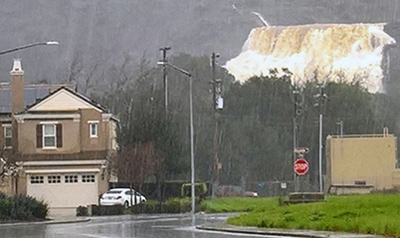
Vol. 81/No. 10 March 13, 2017
(front page)
Devastation by floods in Calif. caused by capitalism, not rain

AND NORTON SANDLER
Up and down the streets in this largely Latino and Asian neighborhood were piles of destroyed furniture, toys and other ruined belongings.
What the politicians and bourgeois press insist — as they wring their hands at their supposed powerlessness — is that the social tragedy caused by the massive rainfall and flooding in California is the unfortunate but unavoidable result of natural causes. But the disaster for working people here is a product of sharp inequalities that are a result of the class relations imposed by capitalism.
In much of the capitalist world, workers only find housing they can begin to afford in low-lying areas given to flooding. This neighborhood is densely packed with families with larger households, nearly twice as many per square mile than the rest of the city, 38 percent of whom were born abroad.
A big pile of ruined belongings stood outside the De Alba’s home. “We had no warning,” Mindy De Alba, who works as a customer service representative, told us. “My mom called me at work saying the house was flooded.”
“You have things like those ‘Amber Alerts,’” her mother Maria said. “Why couldn’t they at least have put out something like that?”
De Alba said the family had to be rescued by one of the boat crews that moved from house to house, pulling families and pets out of the filthy water. “My hats off to the rescuers,” she said. “They did a great job.”
Hundreds of homes, apartments and trailer homes were inundated, some to the rooftops. Most people we talked to, like the De Alba family, first heard about the flood not from city officials but from friends, relatives or co-workers. Many became aware of it only when they saw advancing water. Several told us that their flood insurance covered only the structure of their homes, but nothing inside.
Homeless people who camped along the creek were among the first to confront the rising waters. Some had to be rescued from trees they climbed to escape.
Hours after the floodwaters inundated the area, the government issued a mandatory evacuation order for 14,000 residents.
After a long drought California has been hit by a series of strong rainstorms. Already deteriorating infrastructure at dams and other structures is cracking under the strain. In February, the emergency spillway at California’s highest dam, in Oroville, began to break apart, leading to the belated evacuation of 188,000 people. At least four people have died in the storms.
The flooding in San Jose came after the reservoir at the nearby Anderson dam overflowed, sending water rushing down into Coyote Creek. The reservoir is limited to 68 percent of capacity because of its proximity to an earthquake-prone fault line the state failed to notice when the dam was built.
After inspectors belatedly discovered the dam was vulnerable to a major quake, capacity was restricted and construction was begun to strengthen the dam — but it won’t be finished until 2024.
In the face of inaction by city officials, it was left to residents and their neighbors, friends and relatives to help each other. Carman Grota’s husband, a lineman for a tech company, worked with neighbors to unclog the drain down the street.
Four days after the flood, Gabriel Bravo, a maintenance worker with the school district, was still pumping water from his basement onto the sidewalk. He told us the house, bought by the family in 1982, has been condemned, with the foundation too damaged to salvage.
“The water district went and measured the creek for three straight days and nobody said anything to us,” he said. “Then boom the water came.”
Bravo, along with four other workers we spoke to, subscribed to the Militant newspaper. Interest in the paper increased when we showed them an article explaining how the revolutionary government and the people in Cuba were organized to prevent the loss of life during Hurricane Mathew in 2016. When the hurricane hit Haiti and the U.S., people were left to fend for themselves. Over 1,000 were killed in Haiti and at least 23 in the U.S.
The same Category 4 hurricane ravaged Cuba, but there was not a single fatality. The government and people mobilized to evacuate everyone, and their pets, from harm’s way, and organized to rebuild homes and infrastructure afterwards.
The difference between Cuba and the United States is the revolution workers and farmers made there in 1959, we explained, and overturned the capitalist social relations we suffer under here.
In the wake of the outcry over the lack of notice and support from the city, San Jose Mayor Sam Liccardo was forced to admit something had gone terribly wrong.
“If the first time a resident is aware that they need to get out of a home is when they see a firefighter in a boat,” Liccardo told a Feb. 22 press conference, “something went wrong.”
Front page (for this issue) | Home | Text-version home